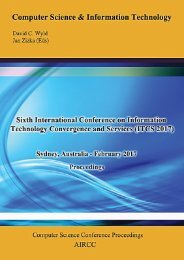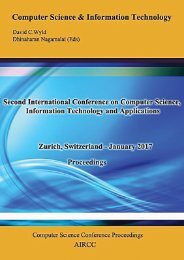CoSIT 2017
Fourth International Conference on Computer Science and Information Technology ( CoSIT 2017 ), Geneva, Switzerland - March 2017
Fourth International Conference on Computer Science and Information Technology ( CoSIT 2017 ), Geneva, Switzerland - March 2017
Create successful ePaper yourself
Turn your PDF publications into a flip-book with our unique Google optimized e-Paper software.
32 Computer Science & Information Technology (CS & IT)<br />
wider bandwidth to the wavelet. Further for the detection of the results this has been changed to<br />
100MHz giving better resolution of the detected bits. This is an advantage of this algorithm as<br />
higher number of bits can be detected with better resolution.<br />
The detected signal is compared with the wavelet, and a coefficient is defined to represent how<br />
closely correlated the wavelet is with each part of the signal. The larger the coefficient is in<br />
absolute value, the more the similarity appears. The wavelet is shifted until it covers the whole<br />
signal. The threshold coefficient is defined after performing the experiment for the tag with bit<br />
‘11111’ number of times under different environmental changes. By the variation in the detected<br />
signal under different circumstances a minimum and maximum coefficient is set giving rise to a<br />
confident band for detection.<br />
Figure 3 – New adopted wavelet pattern using Gaussian function<br />
2.3. Flowchart for Detection Algorithm<br />
The flowchart given in Fig 4, shows the steps of the developed algorithm and how it is applied to<br />
the received signal.<br />
First the measured results using VNA are loaded into Matlab. The post processing is performed<br />
using Matlab programming software. The program can be directly downloaded to the<br />
microcontroller of the frequency domain reader developed by the research group which will be<br />
implemented in the next step of this research.<br />
A baseline removal is performed on the first results to remove the nulls of the antenna S11. Then<br />
the wavelet is defined and is integrated with the resulting signal. The tag ID is decoded based on<br />
the condition band defined for the detection.<br />
Experiments have been performed under different indoor dynamic environments such as placing<br />
clutter objects above the chipless RFID tag. Fig 8, shows the placing of hand 7cm above<br />
covering the tag adding back reflection to the received signal. Similarly, a copper plate was also<br />
placed above the tag at 7cm, and the received signal was observed using the VNA.





